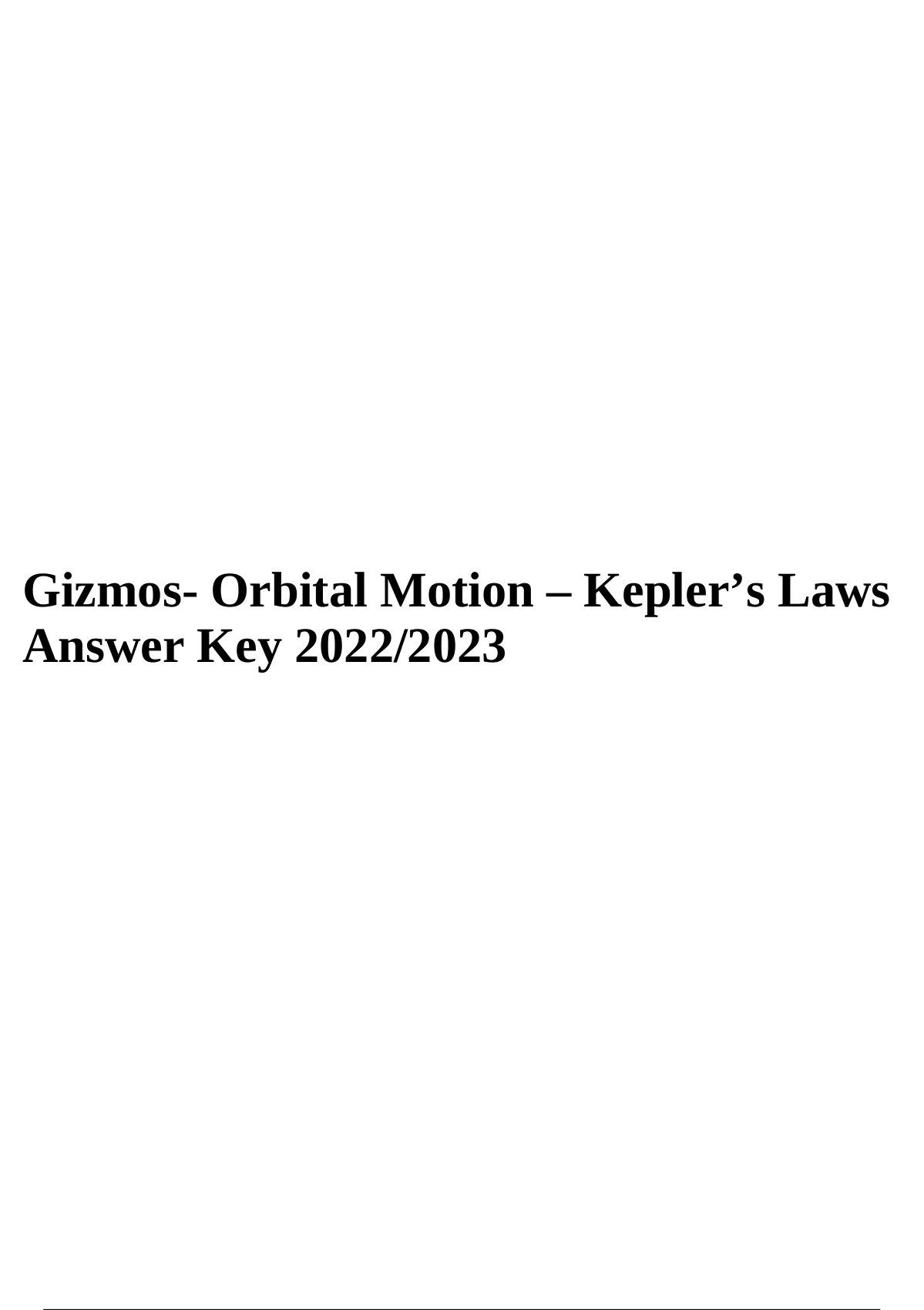1. Hoang M2L3 Kepler's Gizmo (pdf) - Course Sidekick
As it orbits, the planet sweeps out equal areas in equal times. Activity C: Radius and period Get the Gizmo ready: ○ Click Refresh . ○ Set the Sun mass to ...
As you were browsing something about your browser made us think you were a bot. There are a few reasons this might happen:
2. Gizmos orbital motion kepler s laws answer key 2022 - Studypool
Orbital Motion – Kepler's Laws Answer Key Vocabulary: astronomical unit, eccentricity, ellipse, force, gravity, Kepler's first law, Kepler's second law, Kepler ...
Vocabulary: astronomical unit, eccentricity, ellipse, force, gravity, Kepler’s first law, Kepler’ssecond law, Kepler’s third law, orbit, orbital radius, period, vector, velocity

3. [DOC] Orbital Motion – Kepler's Laws
Missing: answers | Show results with:answers
4. SOLUTION: Gismos Orbital Motion Keplers Laws Worksheet - Studypool
You can manipulate both of these factors as you investigate planetary orbits in the Orbital Motion – Kepler's Laws G izmo. On the CONTROLS pane of the Gizmo ...
Directions: Follow the instructions to go through the simulation. Respond to the questions and Vocabulary​:​ astronomical unit, eccentricity, ...

5. Gizmos - Orbital Motion – Kepler's Laws Answer Key 2022 - DocMerit
Nov 15, 2022 · Orbital Motion – Kepler's Laws Answer Key Vocabulary: astronomical unit, eccentricity, ellipse, force, gravity, Kepler's first law, ...
Orbital Motion – Kepler’s Laws Answer Key Vocabulary: astronomical unit, eccentricity, ellipse, force, gravity, Kepler’s first law, Kepler’s second law, Kepler’s third law, orbit, orbital radius, period, vector, velocity Prior Knowledge Questions (Do these BEFORE using the Gizmo.) [Note: The purpos

6. [PDF] Kepler's Laws and Planetary Motion
Read from Lesson 4 of the Circular and Satellite Motion chapter at The Physics Classroom: ... Answer: C a. is longest in winter and shortest in summer b. sweeps ...
7. Gizmos Student Exploration: Orbital Motion – Kepler's Laws - DocMerit
Mar 10, 2022 · GIZMOS STUDENT EXPLORATIO... Gizmos Student Exploration : Carbon Cycle Answer Key. $7.45. 7 pages. Gizmos Student Exploratio... $12.45. Add.
Gizmos Student Exploration: Orbital Motion – Kepler’s LawsGizmos Student Exploration: Orbital Motion – Kepler’s LawsGizmos Student Exploration: Orbital Motion – Kepler’s LawsGizmos Student Exploration: Orbital Motion – Kepler’s LawsGizmos Student Exploration: Orbital Motion – Kepler’s LawsGizmos Stu

8. [DOC] Teacher Guide: Orbital Motion – Kepler's Laws
Activity C – Students find the relationship between a planet's orbital radius and period. Suggested Lesson Sequence. Pre-Gizmo activity: Solar System ...
9. [PDF] Solutions to Physics I Gravity and Kepler's Laws Practice Problems
The orbital period of Titan is 15.95 days. Hyperion, another moon of Saturn, orbits at a mean radius of 1.48x109 m. Use Kepler's third law of planetary motion ...
10. 7.1 Kepler's Laws of Planetary Motion - Physics | OpenStax
Mar 26, 2020 · (c) The aphelion (ra) is the furthest distance between the planet ... Use the Check Your Answers questions to assess whether students master the ...
Examples of orbits abound. Hundreds of artificial satellites orbit Earth together with thousands of pieces of debris. The moon’s orbit around Earth has ...

11. [PDF] Gizmo Orbital Motion Answer Key
6 days ago · Chapters provide insight into the structure, composition and activity of the Sun, ... c rapide sucht eine klassische fahrmaschine der wird ...
12. [PDF] Gizmo vectors answers
... planetary orbits in the Orbital Motion – Kepler's Laws Gizmo™. On the ... (Activity C continued on next page) Activity C (continued from previous page) ...
13. Gizmos- Orbital Motion – Kepler's Laws Answer Key 2022/2023. - Stuvia
... orbit? The orbit becomes smaller and more flattened. Slowest Fastest This study source was downloaded by from CourseH on :10:13 GMT -05:00 2019 Activity A ...
Prior Knowledge Questions (Do these BEFORE using the Gizmo.) [Note: The purpose of these questions is to activate prior knowledge and get students thinking. Students are not expected to know the answers to the Prior Knowledge Questions.] 1. The orbit of Halley’s Comet, shown at right, has an oval shape. In which part of its orbit do you think Halley’s Comet travels fastest? Slowest? Mark these points on the diagram at right. 2. How might a collision between Neptune and Halley’s Comet affect Neptune’s orbit? Answers will vary. [A collision would probably cause a small change in Neptune’s orbit, but would not have a drastic effect on Neptune’s orbit because Neptune is much more massive than Halley’s Comet.] Gizmo Warm-up The path of each planet around the Sun is determined by two factors: its current velocity (speed and direction) and the force of gravity on the planet. You can manipulate both of these factors as you investigate planetary orbits in the Orbital Motion – Kepler’s Laws Gizmo. On the CONTROLS pane of the Gizmo, turn on Show trails and check that Show vectors is on. Click Play ( ). 1. What is the shape of the planet’s orbit? An oval 2. Watch the orbit over time. Does the orbit ever change, or is it stable? The orbit is stable. 3. Click Reset ( ). Drag the tip of the purple arrow to shorten it and reduce the planet’s initial velocity. Click Play. How does this affect the shape of the orbit? The orbit becomes smaller and more flattened. Slowe...

14. [PDF] Kepler's Laws Activity.pages
How does the speed of all three planets' orbits at perihelion compare to the speed of the planet's orbit at aphelion? In your answer use the words. “perihelion” ...
15. [PDF] Physical Setting/Chemistry - JMAP
Jun 16, 2023 · Record your answers for the questions in. Part B–2 and Part C in your separate answer booklet. ... Molecular motion increases. 58 [1] Allow ...